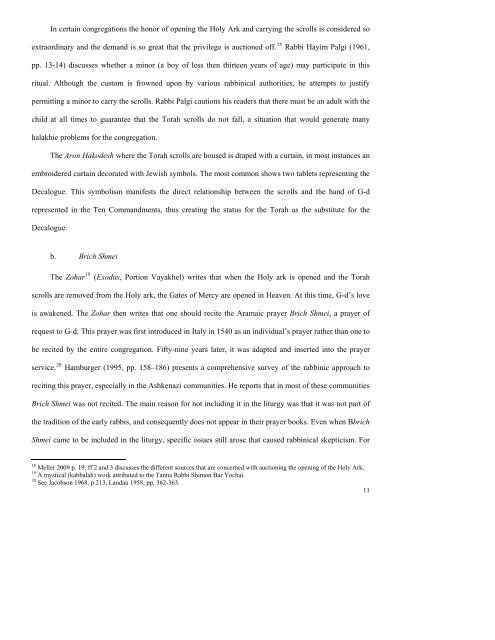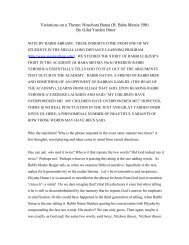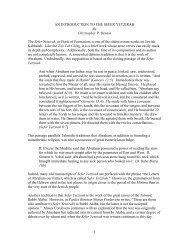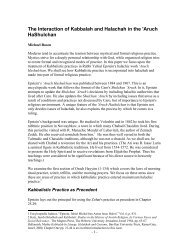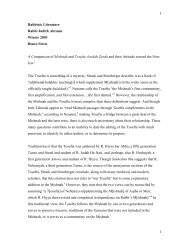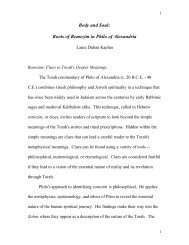The Symbolic Representation of the Sefer Torah - Maqom
The Symbolic Representation of the Sefer Torah - Maqom
The Symbolic Representation of the Sefer Torah - Maqom
Create successful ePaper yourself
Turn your PDF publications into a flip-book with our unique Google optimized e-Paper software.
In certain congregations <strong>the</strong> honor <strong>of</strong> opening <strong>the</strong> Holy Ark and carrying <strong>the</strong> scrolls is considered soextraordinary and <strong>the</strong> demand is so great that <strong>the</strong> privilege is auctioned <strong>of</strong>f. 18 Rabbi Hayim Palgi (1961,pp. 13-14) discusses whe<strong>the</strong>r a minor (a boy <strong>of</strong> less <strong>the</strong>n thirteen years <strong>of</strong> age) may participate in thisritual. Although <strong>the</strong> custom is frowned upon by various rabbinical authorities, he attempts to justifypermitting a minor to carry <strong>the</strong> scrolls. Rabbi Palgi cautions his readers that <strong>the</strong>re must be an adult with <strong>the</strong>child at all times to guarantee that <strong>the</strong> <strong>Torah</strong> scrolls do not fall, a situation that would generate manyhalakhic problems for <strong>the</strong> congregation.<strong>The</strong> Aron Hakodesh where <strong>the</strong> <strong>Torah</strong> scrolls are housed is draped with a curtain, in most instances anembroidered curtain decorated with Jewish symbols. <strong>The</strong> most common shows two tablets representing <strong>the</strong>Decalogue. This symbolism manifests <strong>the</strong> direct relationship between <strong>the</strong> scrolls and <strong>the</strong> hand <strong>of</strong> G-drepresented in <strong>the</strong> Ten Commandments, thus creating <strong>the</strong> status for <strong>the</strong> <strong>Torah</strong> as <strong>the</strong> substitute for <strong>the</strong>Decalogue.b. Brich Shmei<strong>The</strong> Zohar 19 (Exodus, Portion Vayakhel) writes that when <strong>the</strong> Holy ark is opened and <strong>the</strong> <strong>Torah</strong>scrolls are removed from <strong>the</strong> Holy ark, <strong>the</strong> Gates <strong>of</strong> Mercy are opened in Heaven. At this time, G-d’s loveis awakened. <strong>The</strong> Zohar <strong>the</strong>n writes that one should recite <strong>the</strong> Aramaic prayer Brich Shmei, a prayer <strong>of</strong>request to G-d. This prayer was first introduced in Italy in 1540 as an individual’s prayer ra<strong>the</strong>r than one tobe recited by <strong>the</strong> entire congregation. Fifty-nine years later, it was adapted and inserted into <strong>the</strong> prayerservice. 20 Hamburger (1995, pp. 158–186) presents a comprehensive survey <strong>of</strong> <strong>the</strong> rabbinic approach toreciting this prayer, especially in <strong>the</strong> Ashkenazi communities. He reports that in most <strong>of</strong> <strong>the</strong>se communitiesBrich Shmei was not recited. <strong>The</strong> main reason for not including it in <strong>the</strong> liturgy was that it was not part <strong>of</strong><strong>the</strong> tradition <strong>of</strong> <strong>the</strong> early rabbis, and consequently does not appear in <strong>the</strong>ir prayer books. Even when BbrichShmei came to be included in <strong>the</strong> liturgy, specific issues still arose that caused rabbinical skepticism. For18 Meller 2009 p. 19, ff 2 and 3 discusses <strong>the</strong> different sources that are concerned with auctioning <strong>the</strong> opening <strong>of</strong> <strong>the</strong> Holy Ark.19 A mystical (kabbalah) work attributed to <strong>the</strong> Tanna Rabbi Shimon Bar Yochai.20 See Jacobson 1968, p.213, Landau 1958, pp. 362-363.11


